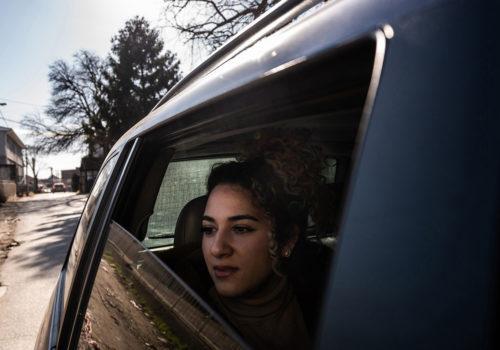Bergamo, a city of Lombardy with unmissable notes of Venetian architecture, dresses itself in images for Fotografica, Festival di Fotografia Bergamo, with twelve exhibitions centred on the human being and its values. NOI, QUI is the title and outline of this fourth edition, which tells the story of man, his emotions, his limits and his fragility, which become a resource for the rescue of the individual and the community.
The Festival is part of the context of Bergamo Brescia Italian Capital of Culture 2023 and is staged in two fascinating architectural settings in the Città Alta, a UNESCO World Heritage Site. They are the ancient Monastero del Carmine and the Ex Magazzini del Sale, with its underground vaults opened for the first time, a true treasure hidden beneath the 15th-century Palazzo della Domus Magna.
Fotografica tells by images the story of humanity engaged in the challenge of everyday life, where courage, resilience, integration, solidarity, culture intended as care, redemption are mixed. A story of universal value, declined by the photographers in a personal way, but with the common language of photography, which engages both rationality and emotion. The Festival also dedicates three exhibitions to sport, considered an instrument of social value and a means of redemption.
Let’s start with the exhibitions at the Monastero del Carmine. In a Window of Prestes Maia 911 Building, by Julio Bittencourt, deals with Brazil and its favelas, poverty, drugs and violence. He documents the largest squatted building in the world, whose occupants are about to be evicted focusing on their individuality.
The Day May Break is an ongoing global series of portraits of people and animals affected by environmental degradation and destruction. Since 2020, Nick Brandt has been shooting in sanctuaries and conservation areas: the animals are almost all long-term rescues, and they are habituated, so it was safe for humans to get close to them and be photographed in the same frame.
The Swedish-based art duo Cooper & Gorfer uses colours and haute couture aesthetics of the images, and portraits of women with dynamic overlapping effects in Between these Folded Walls, Utopia. Behind these images there are stories of women who came to Sweden as migrants and rebuilt their lives with courage.
Edoardo Delille realized the project Elements in and around Brescia, studying the life of a large company set against the history, spirit and identity of the inhabitants while Deanna Dikeman tells about family and the pain of parting in Leaving and Waving. For 27 years, she has taken photos of herself saying goodbye to her parents after visiting them. The passage of time, her parents’ illness and their disappearance become, in this visual linearity, inevitable and touching stages of life.
Roma Revolution by Alessandro Gandolfi is about six young, committed girls and the messages they send to their peers through music (in Romani): fight abuse, don’t drop out of school, emancipate yourselves. Today, with nearly 200,000 views on YouTube, the band has sung for the United Nations and even made the front page of the New York Times. For La liberazione della follia, Patrizia Riviera collaborated with the Emilia Bosis Foundation, a non-profit organization dedicated to mental health. Over the past 20 years, she has accompanied the Foundation in all its projects: horse and carriage rides, plays written and staged by patients together with avant-garde stage directors, fashion and photography workshops.
Curated by Laura Leonelli, the exhibition I won’t come down. Stories of women who climb trees and look into the distance, which is also collected in a book (Postcart publ.), presents a series of anonymous photographs telling how for centuries women have remained entrenched in the ground, under the trees, like roots, whose destiny is to feed other beings, fathers, husbands, sons who, instead, are free to climb and look ahead. But at a certain point, the women hugged the trees, climbing them: so they reached another point of view more open, higher, deeper, clearer. And they said: “I won’t come down”. And each woman photographed, even without a name, becomes part of a larger story.
More than 200,000 people are forced to live in IDP camps in Chad after one of the worst floods in its history in 2022. Apnea by Fausto Podavini for Medici Senza Frontiere, tells that what happened is an example of “climate change”, with devastating consequences for people’s health.
The ex Magazzini del Sale host exhibitions dedicated to the sport. Maurizio Galimberti, who has been working on Polaroid photography since 1983, in Progetto Sport, tra Dada e movimento. Ritmo dinamico in ready recounts the great sporting gestures that have made history and symbolise the values of sport.
Sebastian Gil Miranda presents Na Ponta Dos Pés, a non-profit organisation based in one of the favelas of the Complexo do Alemão in Rio de Janeiro, which aims to promote the empowerment of girls by providing opportunities for growth, learning and social transformation through artistic, cultural and sports educational activities.
In recent years, many popular and independent teams have welcomed refugees and asylum seekers to show that dignified integration is possible, starting with sports. Cover Me with Gold, by Gianmarco Maraviglia tells the story of Sant’Ambroeus Football Club in Milan, the first team of asylum seekers and refugees.
Paola Sammartano
Fotografica, Festival di Fotografia Bergamo is organized by Associazione Fotografica APS in collaboration with the Comune di Bergamo.
Fotografica, Festival di Fotografia Bergamo
October 14 – November 19, 2023
Monastero del Carmine, Via Bartolomeo Colleoni, 21, Città Alta
Ex Magazzini del Sale, via Arena 7/B, Città Alta
24100 Bergamo
Italy
http://www.fotograficafestival.it/
















